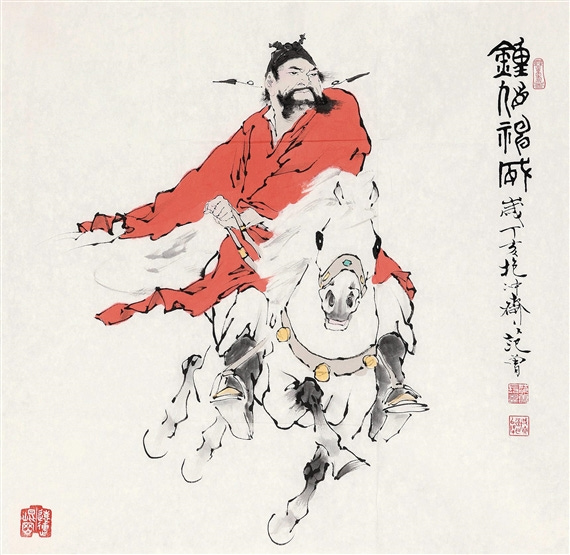You can listen to part II here.
Below you will find the accompanying essay to parts I & parts II of this conversation.
In Zen circles, there is a well-known story of a man on a horse, galloping swiftly down a road. Another man, standing on the side, shouts, “Where are you going?” and the rider replies, “I don’t know! Ask the horse!” This story mirrors our relationship with technology. The horse represents the pace of technological progress, moving faster than we can comprehend, and often in directions we have not considered. We are merely riders, seemingly without control, pulled along by the rapid advancements of the digital world. In the spirit of mindfulness and deep reflection, we can ask: What does it mean to ride this horse wisely? How do we cultivate a relationship with technology that is grounded in wisdom and compassion, rather than fear, greed, or ignorance?
Technology as a Rushing Horse
Technology, like the horse in the story, is propelling us forward at breakneck speed. Social media is a clear example of how technological advancement can have unintentional consequences. While it connects people, it also amplifies tensions, polarizes discourse, and creates addictive patterns of behavior. It is crucial, then, that we slow down and reflect, individually and collectively, on where this galloping horse is taking us. Just as we practice mindful breathing to calm our racing thoughts, we must learn to pause in the face of rapid technological change.
Slowing down is not about rejecting progress. Instead, it is about making time for reflection. There are moments in life where speed is necessary, but wisdom is about recognizing when it is time to slow down. The modern world encourages us to rush, to innovate faster, to create without pause. But perhaps now, the wise thing to do is the opposite: to stop, breathe, and ask ourselves if we are heading in the right direction.
Deep Inquiry into Technology Creation
A wiser approach to technology involves deep inquiry into the source of our actions. When we create new technologies, we must ask: Where is this coming from? Is it motivated by wisdom and compassion, or is it driven by fear, greed, or ignorance? In our current model of technological development, particularly in places like Silicon Valley, the focus is on speed and efficiency. Entrepreneurs are encouraged to build prototypes quickly, to seek out markets, and to scale their businesses as rapidly as possible. However, what if we introduced a different approach?
Imagine if, instead of rushing into product development, the first weeks at an incubator like Y Combinator were spent in deep reflection. What if creators were asked to meditate on their intentions, to explore whether their innovations were coming from a place of love and compassion, or from a place of ego and competition? This though experiment illustrates what it could look like to have a shift towards wise, mindful creation. If we build technology with wisdom, we can ensure that it serves humanity in ways that are compassionate and beneficial, rather than harmful.
However, collective action requires a shift in worldview. The modern world is deeply individualistic, idealizing personal freedom and autonomy while viewing collective action with skepticism. Yet, if we are to navigate the challenges of the digital age, we must embrace a worldview of interconnectedness – of “interbeing.” We are not isolated individuals; we are deeply interconnected with each other and with the world around us. This recognition of interbeing invites us to approach technology not as solitary innovators, but as members of a larger whole, working together for the collective good.
Cultivating Wisdom Beyond Reason
In cultivating a second renaissance approach to technology, it is essential to recognize that wisdom transcends reason. While rationality and logic are valuable, humans are not purely rational beings. We are also guided by emotions, values, and deeper intuitions. Wisdom, in this sense, integrates both the rational and the non-rational aspects of our being. It allows us to look beyond immediate benefits or profits and to consider the long-term impact of our actions on society, the environment, and future generations.
To approach technology wisely, we must also cultivate a deeper understanding of ourselves. Thich Nhat Hanh often emphasizes the importance of knowing what we truly want, as opposed to what we think we want. In the realm of technology, this means moving beyond superficial desires for convenience, novelty, or profit, and asking deeper questions about what kind of world we want to create. This requires effort, patience, and support, both individually and collectively. It requires us to look deeply at our motivations and to align our technological innovations with our highest values.
Conclusion: A Second Renaissance Approach
A second renaissance, metamodern approach to technology is one that integrates wisdom, mindfulness, and collective action.
By slowing down, reflecting deeply, and acting collectively, we can shape technology in ways that are aligned with compassion, interconnectedness, and the well-being of all. This is the invitation of the present moment: to take the reins of the rushing horse, not to stop its progress, but to guide it wisely, with care and consideration for all beings.









Share this post